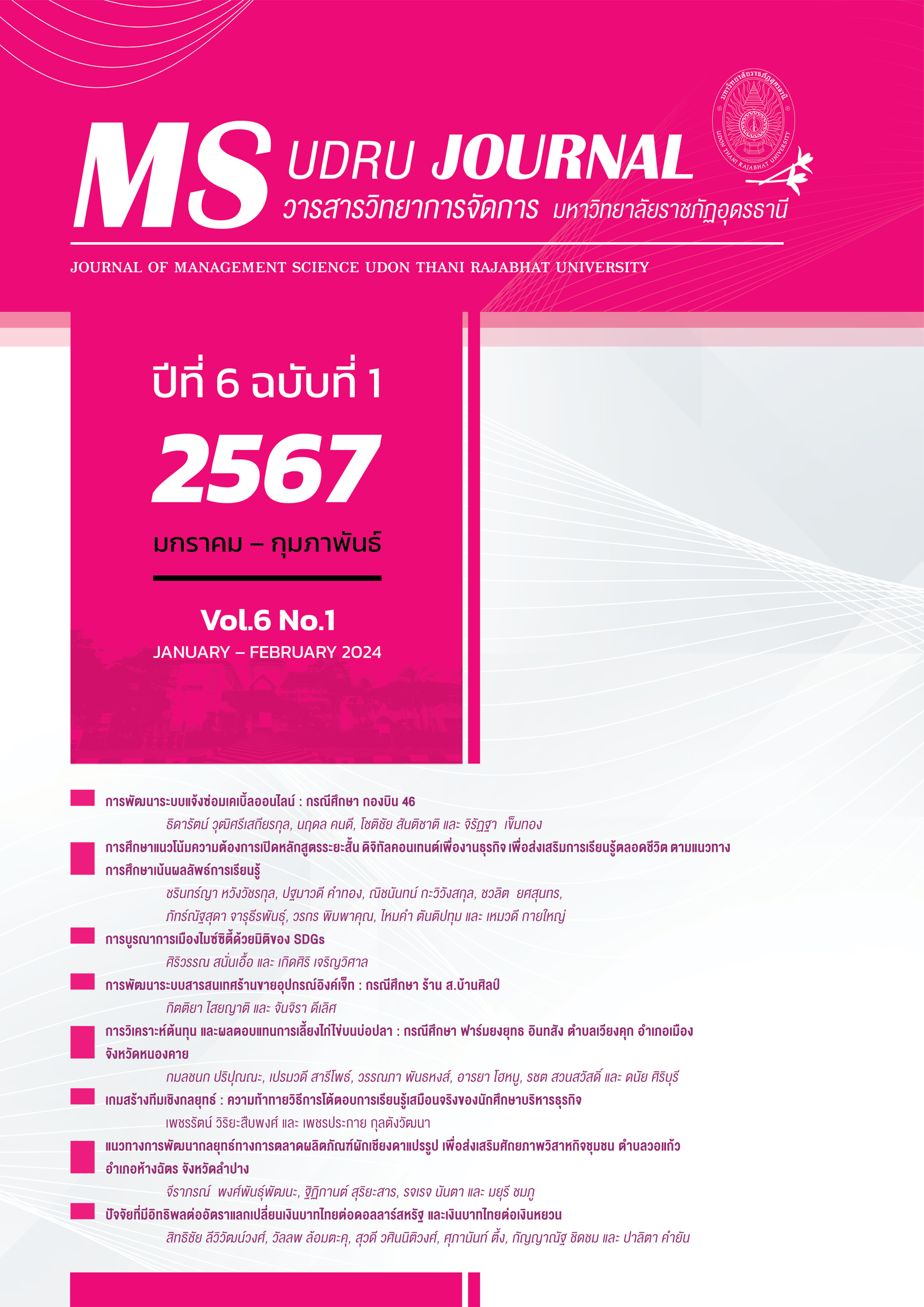COST AND RETURN ANALYSIS OF LAYING HENS ON FISH PONDS : CASE STUDY YONGYUT INTHASANG FARM, WIANG COOK SUBDISTRICT, MUEANG DISTRICT, NONGKHAI PROVINCE
Main Article Content
Abstract
A case study of the cost and return on investment (ROI) of Yongyut Farm in Nong Khai, Thailand. The objectives of this research: to study the process of raising layer chickens on fish ponds; to study the costs and ROI of raising layer chickens on fish ponds; to identify the challenges of raising layer chickens on fish ponds. The data was collected by interviewing the owner of Yongyut Inthasang Farm. The results showed that the average cost per production cycle of laying hens on fish ponds. consists of an initial investment of 255,800 baht, direct raw materials of 1,032,600 baht, direct labor costs of 244,000 baht, production expenses of 57,710.14 baht, production costs of 1,321,100.14 baht, sales and management expenses of 75,480 baht, and an average annual net profit of 319,419.86 baht. There is a payback period of 1 production cycle. The (ROI) is 124.87%, the gross profit margin per sale was 23.01% and the net profit per sales ratio was 18.61%. Moreover, we identified challenges such as intrusion by external enemies such as snakes. Therefore, countermeasures should be developed to protect the farm from external enemies. Lastly, we found that the main cost factor was the cost of food. If efficiencies can be gained in food cost the farm’s net profit would increase.
Article Details

This work is licensed under a Creative Commons Attribution-NonCommercial-NoDerivatives 4.0 International License.
บทความที่ได้รับการตีพิมพ์เป็นลิขสิทธิ์ของคณะวิทยาการจัดการ มหาวิทยาลัยราชภัฏอุดรธานี
ข้อความที่ปรากฏในบทความแต่ละเรื่องในวารสารวิชาการเล่มนี้ ไม่ใช่ความคิดเห็นและความรับผิดชอบของผู้จัดทำ บรรณาธิการ กองบรรณาธิการ และคณะวิทยาการจัดการ มหาวิทยาลัยราชภัฏอุดรธานี ความรับผิดชอบด้านเนื้อหาและการตรวจร่างบทความแต่ละเรื่องเป็นความคิดเห็นของผู้เขียนบทความแต่ละท่าน
References
กองบรรณาธิการเกษตรกรก้าวหน้า. (2560). ชนิดของวัคซีน. เลี้ยงไก่ไข่อารมณ์ดี, หน้า 107-111
กรมส่งเสริมการเกษตร. (2563). การเลี้ยงไก่ไข่ผสมผสานกับการเลี้ยงปลา. สืบค้นเมื่อ 15 มกราคม 2566, จาก http://sarakaset.com/2021/02/06/combination-of-laying-hens/
กฤตกร กล่องจิต และคณะ (2538). ผลกระทบของอุตสาหกรรมการเลี้ยงไก่ต่อวิถีชีวิตของประชาชนในชนบทอีสาน : กรณีศึกษาอุตสาหกรรมเลี้ยงไก่ไข่ของตำบลปะโค อำเภอเมือง จังหวัดหนองคาย. ใน การประชุมทางวิชาการของมหาวิทยาลัยเกษตรศาสตร์ ครั้งที่ 33, หน้า 458-462. กรุงเทพฯ: มหาวิทยาลัยเกษตรศาสตร์.
คณะทำงานข้อมูลด้านการเกษตรและสหกรณ์จังหวัดหนองคาย. (2566). เอกสารรายงานข้อมูลพื้นฐานด้านการเกษตรและสหกรณ์ จังหวัดหนองคาบ ปี 2566
ฐญามน วงศ์การณ์. (2562). การศึกษาเกี่ยวกับการวิเคราะห์รายได้ ค่าใช้จ่าย และต้นทุนการเลี้ยงไก่ไข่ กรณีศึกษา อาทิตย์ฟาร์ม. สืบค้นเมื่อ 21 กุมภาพันธ์ 2566 จาก https://erp.mju.ac.th/openFile.aspx?id=MzkyMTUz&method=inline
ธาวิดา ศิริสัมพันธ์. (2565). การเลี้ยงไก่ไข่อินทรีย์ 900 ตัว เปลี่ยนขยะให้เป็นศูนย์ต้นทุนต่ำ ทำกำไรตัวละ 3 บาท ต่อวัน. เทคโนโลยีชาวบ้าน, 34 (774), หน้า22-25.
ยุทธศักดิ์ ขุนทอง. (2560). เปลี่ยนสัตว์เลี้ยงใต้ถุนบ้านสู่มินิฟาร์มทำรายได้ไม่รู้จบ. ต้นแบบเกษตรกรรม "อยู่ดี กินดี" ด้วยเกษตรทฤษฎีใหม่, 1(2), 88-93.
ยุทธศักดิ์ ขุนทอง. (2561). ไก่พื้นเมือง เลี้ยงกึ่งปิด/ปล่อย สร้างรายได้ไม่ธรรมดา สัตว์เศรษฐกิจพื้นบ้าน มรดกทำกิน สร้างอาชีพ, 1(1), 48-51.
สมาคมผู้ผลิตอาหารสัตว์ไทย.(2556). สถานการณ์ไข่ไก่. สืบค้นเมื่อ 23 มีนาคม 2566 จาก http://www.eggthailand.com/upload/images/Document
สุรเชษฐ์ ปินทิพย์ และคณะ. การเลี้ยงไก่ไข่และการบริหารกลุ่มเกษตรกรผู้เลี้ยงไก่ไข่ อำเภอทุ่งช้าง จังหวัดน่าน. สืบค้นเมื่อ 23 มีนาคม 2566, จาก http://www.stou.ac.th/thai/grad_stdy/masters.pdf
สุรเดช สดคมขำ. (2562). เกษตรกรหญิงจันทบุรี เลี้ยงไก่ไข่อินทรีย์ ไกมีอายุถึง 3 ปี ไข่ขายได้ราคาดี. เทคโนโลยีชาวบ้าน, 31(699), 69-71.

